Reasons for Companies to Disclose Intellectual Capital Information
VerifiedAdded on 2022/11/25
|7
|1788
|317
Essay
AI Summary
This essay explores the rationale behind companies disclosing intellectual capital (IC) information within the narrative sections of their corporate annual reports. It begins by defining IC as intangible assets encompassing human, structural, and relational capital, crucial for creating company value in the current economic landscape. The essay delves into the benefits of such disclosures, including enhanced transparency, improved investor relations by reducing uncertainty, strategic alignment, and facilitating decision-making. It also examines the costs, such as the expenses associated with data assembly and potential competitive disadvantages. The essay references key literature to support its arguments, highlighting the importance of IC disclosure in formulating business strategies, assessing execution, and communicating with stakeholders. It concludes by emphasizing the significance of IC disclosure in attracting investment and its influence on the cost of equity capital. The essay also acknowledges limitations, such as measurement challenges and the need for auditor conservatism.
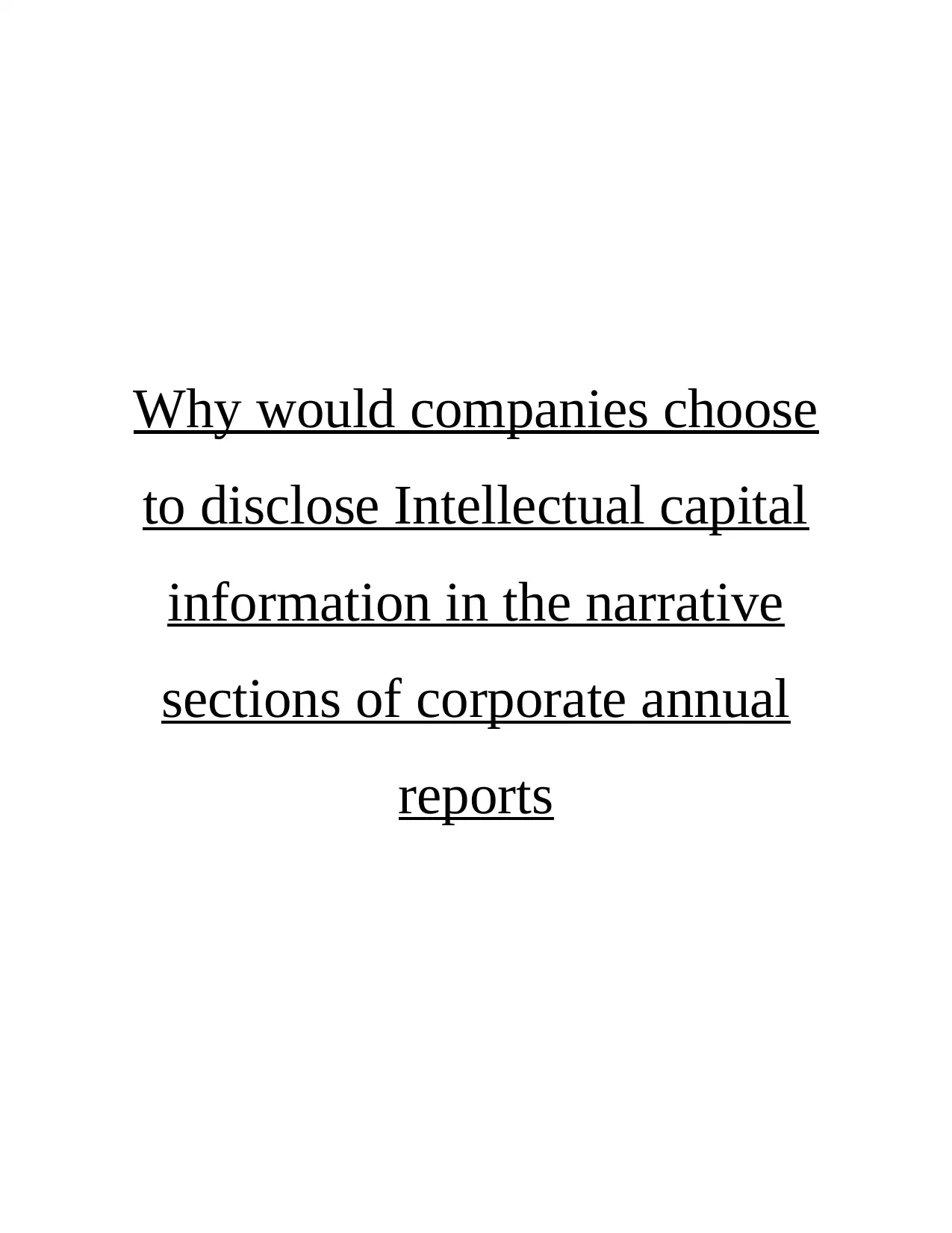
Why would companies choose
to disclose Intellectual capital
information in the narrative
sections of corporate annual
reports
to disclose Intellectual capital
information in the narrative
sections of corporate annual
reports
Paraphrase This Document
Need a fresh take? Get an instant paraphrase of this document with our AI Paraphraser
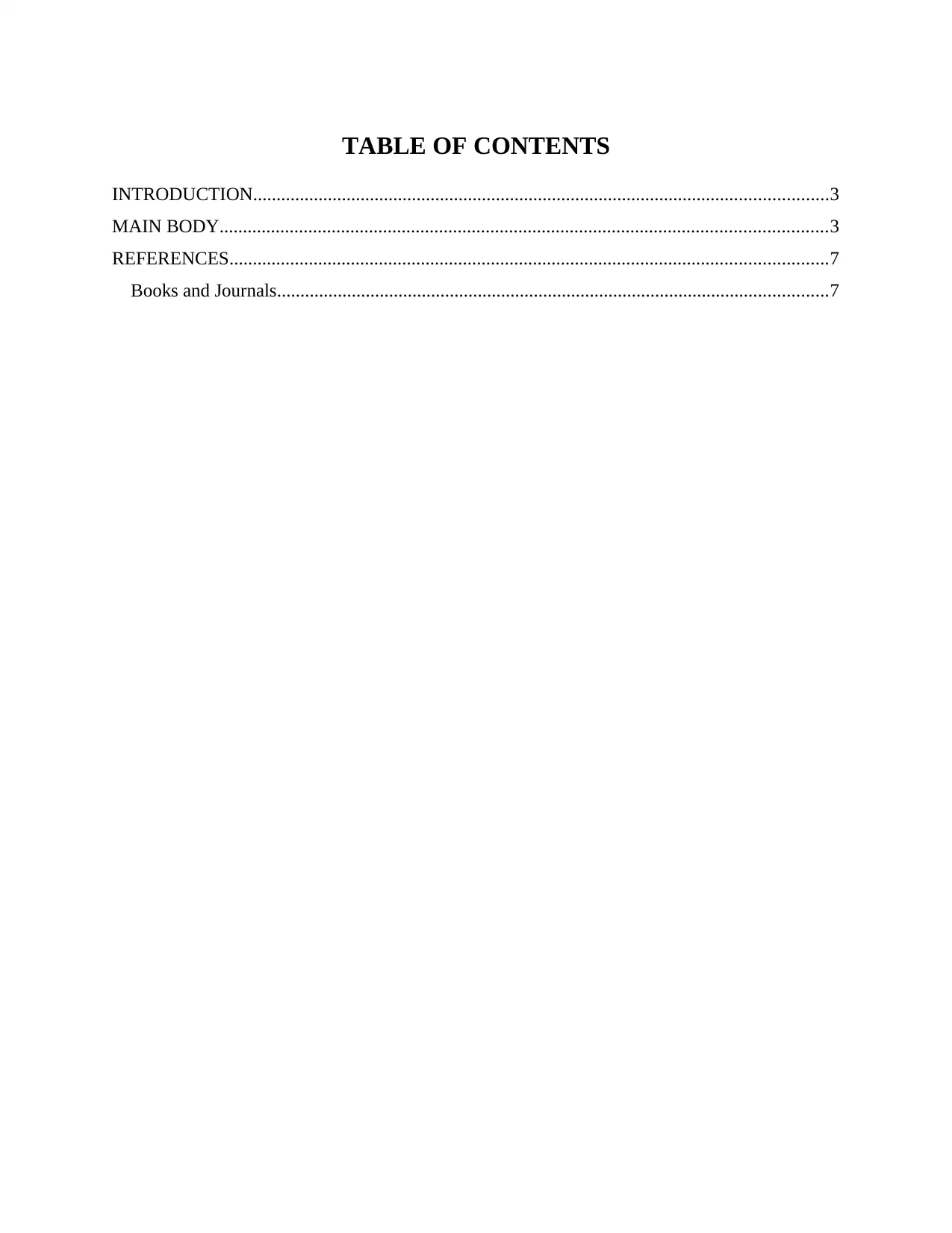
TABLE OF CONTENTS
INTRODUCTION...........................................................................................................................3
MAIN BODY..................................................................................................................................3
REFERENCES................................................................................................................................7
Books and Journals......................................................................................................................7
INTRODUCTION...........................................................................................................................3
MAIN BODY..................................................................................................................................3
REFERENCES................................................................................................................................7
Books and Journals......................................................................................................................7

INTRODUCTION
Intellectual capital are the intangible assets which are associated with the companies. It us
related to the expertise of employees, the process of the organisation and the knowledge
contained within the organisation (Allameh, 2018). The method to measure the intellectual
capital varies depending on the organisation. Organisation can increase the intellectual capital by
on boarding more employees, providing them training and developing new patents. The
importance for intellectual capital information is increased because of the current economic
condition.
MAIN BODY
Intellectual capital intangible resources are used to create a certain value for the
organisation. Some of the main intangible capital are human capital, structural capital and
relational capital. Disclosure of the intellectual capital in the annual reports is done by
determining the frequency of disclosure regarding the intellectual capital item is assessed. It is
the set of non financial and non physical resources which are used to gain competitive advantage
to the organisation (Kianto, Sáenz, and Aramburu, 2017). Intellectual capital is the intellectual
material which can be used to create wealth. Relational capital includes all the resources which
are connected to the external relations of the organisation. These external relations are with
customers, suppliers and even the partners in the process of research and development. It is the
combination of human and structural capital related to the organisation and its stockholders.
Human capital on the hand can be said to be the parameter used in the improving the
organisation. It includes employees which are used to increase the productivity and gain the
competitive advantage to sustain in the market. Human capital represents skills, knowledge,
capabilities and also the innovativeness regarding a particular problem.
Intellectual capital disclosure is defined as the report which is used to meet the
information needs and requirements to the common users. Such users are not capable to
command for the preparation of reports related to the intellectual capital. It is used to satisfy all
the information needs of the people (Chowdhury, Rana, and Azim, 2019). Intellectual capital
disclosure is a method which is used to measure the intangible assets of the company while
explaining the results coming from the knowledge of company and its activities. The type of
intellectual capital disclosure is information which is very valuable for the investors. It helps the
Intellectual capital are the intangible assets which are associated with the companies. It us
related to the expertise of employees, the process of the organisation and the knowledge
contained within the organisation (Allameh, 2018). The method to measure the intellectual
capital varies depending on the organisation. Organisation can increase the intellectual capital by
on boarding more employees, providing them training and developing new patents. The
importance for intellectual capital information is increased because of the current economic
condition.
MAIN BODY
Intellectual capital intangible resources are used to create a certain value for the
organisation. Some of the main intangible capital are human capital, structural capital and
relational capital. Disclosure of the intellectual capital in the annual reports is done by
determining the frequency of disclosure regarding the intellectual capital item is assessed. It is
the set of non financial and non physical resources which are used to gain competitive advantage
to the organisation (Kianto, Sáenz, and Aramburu, 2017). Intellectual capital is the intellectual
material which can be used to create wealth. Relational capital includes all the resources which
are connected to the external relations of the organisation. These external relations are with
customers, suppliers and even the partners in the process of research and development. It is the
combination of human and structural capital related to the organisation and its stockholders.
Human capital on the hand can be said to be the parameter used in the improving the
organisation. It includes employees which are used to increase the productivity and gain the
competitive advantage to sustain in the market. Human capital represents skills, knowledge,
capabilities and also the innovativeness regarding a particular problem.
Intellectual capital disclosure is defined as the report which is used to meet the
information needs and requirements to the common users. Such users are not capable to
command for the preparation of reports related to the intellectual capital. It is used to satisfy all
the information needs of the people (Chowdhury, Rana, and Azim, 2019). Intellectual capital
disclosure is a method which is used to measure the intangible assets of the company while
explaining the results coming from the knowledge of company and its activities. The type of
intellectual capital disclosure is information which is very valuable for the investors. It helps the
⊘ This is a preview!⊘
Do you want full access?
Subscribe today to unlock all pages.

Trusted by 1+ million students worldwide
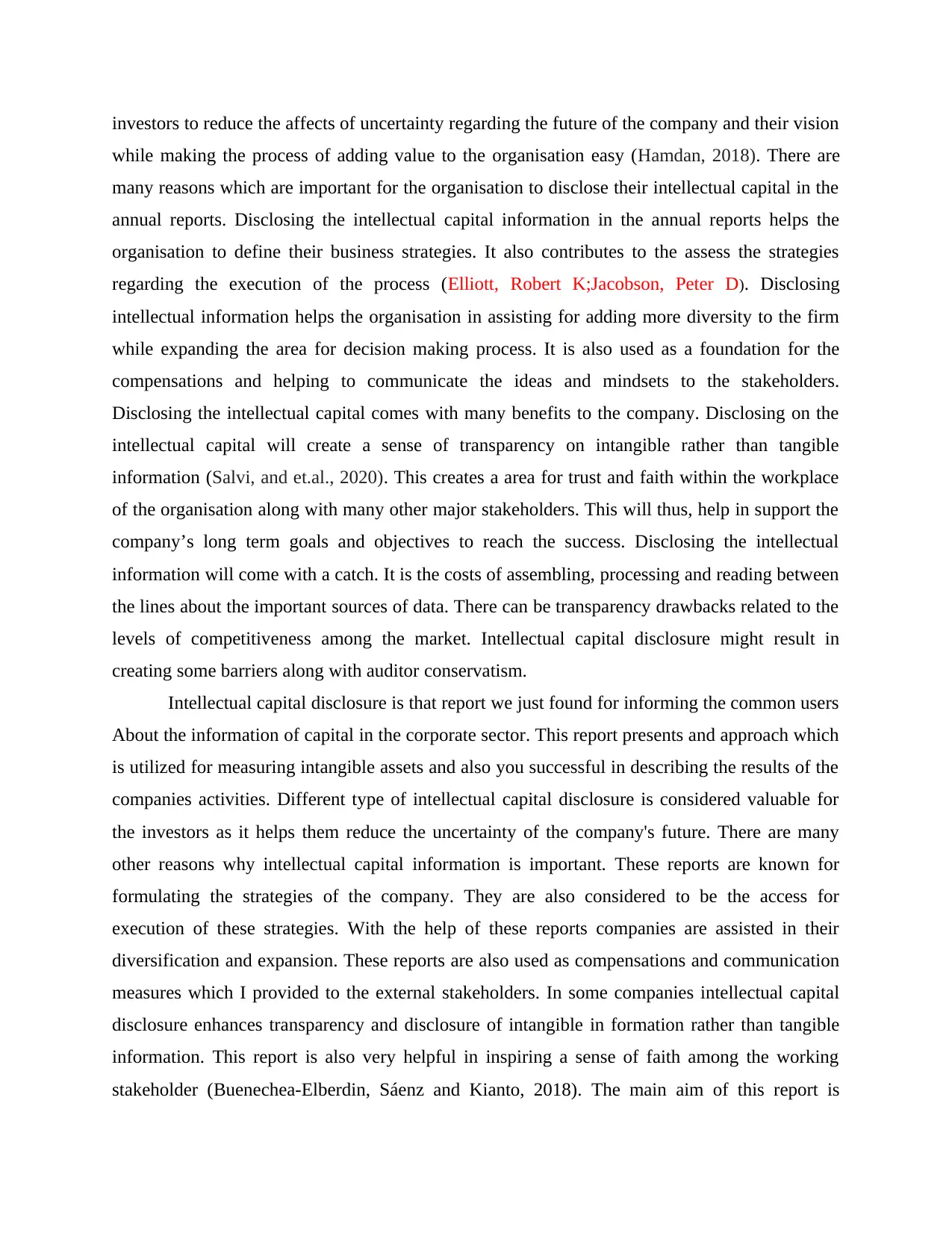
investors to reduce the affects of uncertainty regarding the future of the company and their vision
while making the process of adding value to the organisation easy (Hamdan, 2018). There are
many reasons which are important for the organisation to disclose their intellectual capital in the
annual reports. Disclosing the intellectual capital information in the annual reports helps the
organisation to define their business strategies. It also contributes to the assess the strategies
regarding the execution of the process (Elliott, Robert K;Jacobson, Peter D). Disclosing
intellectual information helps the organisation in assisting for adding more diversity to the firm
while expanding the area for decision making process. It is also used as a foundation for the
compensations and helping to communicate the ideas and mindsets to the stakeholders.
Disclosing the intellectual capital comes with many benefits to the company. Disclosing on the
intellectual capital will create a sense of transparency on intangible rather than tangible
information (Salvi, and et.al., 2020). This creates a area for trust and faith within the workplace
of the organisation along with many other major stakeholders. This will thus, help in support the
company’s long term goals and objectives to reach the success. Disclosing the intellectual
information will come with a catch. It is the costs of assembling, processing and reading between
the lines about the important sources of data. There can be transparency drawbacks related to the
levels of competitiveness among the market. Intellectual capital disclosure might result in
creating some barriers along with auditor conservatism.
Intellectual capital disclosure is that report we just found for informing the common users
About the information of capital in the corporate sector. This report presents and approach which
is utilized for measuring intangible assets and also you successful in describing the results of the
companies activities. Different type of intellectual capital disclosure is considered valuable for
the investors as it helps them reduce the uncertainty of the company's future. There are many
other reasons why intellectual capital information is important. These reports are known for
formulating the strategies of the company. They are also considered to be the access for
execution of these strategies. With the help of these reports companies are assisted in their
diversification and expansion. These reports are also used as compensations and communication
measures which I provided to the external stakeholders. In some companies intellectual capital
disclosure enhances transparency and disclosure of intangible in formation rather than tangible
information. This report is also very helpful in inspiring a sense of faith among the working
stakeholder (Buenechea-Elberdin, Sáenz and Kianto, 2018). The main aim of this report is
while making the process of adding value to the organisation easy (Hamdan, 2018). There are
many reasons which are important for the organisation to disclose their intellectual capital in the
annual reports. Disclosing the intellectual capital information in the annual reports helps the
organisation to define their business strategies. It also contributes to the assess the strategies
regarding the execution of the process (Elliott, Robert K;Jacobson, Peter D). Disclosing
intellectual information helps the organisation in assisting for adding more diversity to the firm
while expanding the area for decision making process. It is also used as a foundation for the
compensations and helping to communicate the ideas and mindsets to the stakeholders.
Disclosing the intellectual capital comes with many benefits to the company. Disclosing on the
intellectual capital will create a sense of transparency on intangible rather than tangible
information (Salvi, and et.al., 2020). This creates a area for trust and faith within the workplace
of the organisation along with many other major stakeholders. This will thus, help in support the
company’s long term goals and objectives to reach the success. Disclosing the intellectual
information will come with a catch. It is the costs of assembling, processing and reading between
the lines about the important sources of data. There can be transparency drawbacks related to the
levels of competitiveness among the market. Intellectual capital disclosure might result in
creating some barriers along with auditor conservatism.
Intellectual capital disclosure is that report we just found for informing the common users
About the information of capital in the corporate sector. This report presents and approach which
is utilized for measuring intangible assets and also you successful in describing the results of the
companies activities. Different type of intellectual capital disclosure is considered valuable for
the investors as it helps them reduce the uncertainty of the company's future. There are many
other reasons why intellectual capital information is important. These reports are known for
formulating the strategies of the company. They are also considered to be the access for
execution of these strategies. With the help of these reports companies are assisted in their
diversification and expansion. These reports are also used as compensations and communication
measures which I provided to the external stakeholders. In some companies intellectual capital
disclosure enhances transparency and disclosure of intangible in formation rather than tangible
information. This report is also very helpful in inspiring a sense of faith among the working
stakeholder (Buenechea-Elberdin, Sáenz and Kianto, 2018). The main aim of this report is
Paraphrase This Document
Need a fresh take? Get an instant paraphrase of this document with our AI Paraphraser

supporting the long term vision Of a specific organization.
Such reports do cost the corporate sector. Companies have to spend the cost of gathering
processing and interpreting of the required data some factors which I considered to be a
drawback in intellectual capital disclosure is the transparency it has in the competitive market. it
is also seen to face barriers in its regulation. For the success of this report it is important for the
auditor to be conservative. The idea behind intellectual capital reporting is that the traditional
financial information concerns about all the past performance of the company and does not talk
about the potential future of the enterprise. The reporting of intellectual capital Create
transparency which allows the managers on the company to understand its intangible resources
effectively. With the creation of transparency the managers are helped with the allocation of
resources and monitoring of development. In short, it can also be said that it facilitates the
decision-making of the company ask her the European Commission intellectual capital reporting
is emphasized of mainly two reasons, one being it provides additional information which is used
further management of the company. Secondly this report provides the compliments to the
financial statement of the company, which indeed is helpful for it’s image (Buallay, and
et.al.,2020).
The intellectual capital disclosure reports have been found with the following limitation
which the companies need to understand before framing a report. The biggest issue with this
report is that is consists of measurement issues. Generally these reports where found to be
measured with the help of dichotomous procedure. The main issue with such procedure is that it
fails in differentiating firms on the basis of the details provided by them. The results of this
procedure is based on judgement and certain information may or may not be viable in the
judgement process. According to some study it has been known that the certain results of the
intellectual capital disclosure is already known and some time these reports also are useless.
However, The study of this report helping the investigation about the capital disclosure on
weather it is associated with the cost of equity capital. The intellectual capital report is
responsible for attracting the interest off regulatory bodies, managers, practitioners and
academics. This has been the reason why currently disclosure of investments has been done very
consecutively in most of the organization. Due to this financial intellectual report It has been
argued that financial statements have lost there relevance as they fail To reflect the capital
investments. With the help of this report many researchers have been influenced to investigate
Such reports do cost the corporate sector. Companies have to spend the cost of gathering
processing and interpreting of the required data some factors which I considered to be a
drawback in intellectual capital disclosure is the transparency it has in the competitive market. it
is also seen to face barriers in its regulation. For the success of this report it is important for the
auditor to be conservative. The idea behind intellectual capital reporting is that the traditional
financial information concerns about all the past performance of the company and does not talk
about the potential future of the enterprise. The reporting of intellectual capital Create
transparency which allows the managers on the company to understand its intangible resources
effectively. With the creation of transparency the managers are helped with the allocation of
resources and monitoring of development. In short, it can also be said that it facilitates the
decision-making of the company ask her the European Commission intellectual capital reporting
is emphasized of mainly two reasons, one being it provides additional information which is used
further management of the company. Secondly this report provides the compliments to the
financial statement of the company, which indeed is helpful for it’s image (Buallay, and
et.al.,2020).
The intellectual capital disclosure reports have been found with the following limitation
which the companies need to understand before framing a report. The biggest issue with this
report is that is consists of measurement issues. Generally these reports where found to be
measured with the help of dichotomous procedure. The main issue with such procedure is that it
fails in differentiating firms on the basis of the details provided by them. The results of this
procedure is based on judgement and certain information may or may not be viable in the
judgement process. According to some study it has been known that the certain results of the
intellectual capital disclosure is already known and some time these reports also are useless.
However, The study of this report helping the investigation about the capital disclosure on
weather it is associated with the cost of equity capital. The intellectual capital report is
responsible for attracting the interest off regulatory bodies, managers, practitioners and
academics. This has been the reason why currently disclosure of investments has been done very
consecutively in most of the organization. Due to this financial intellectual report It has been
argued that financial statements have lost there relevance as they fail To reflect the capital
investments. With the help of this report many researchers have been influenced to investigate
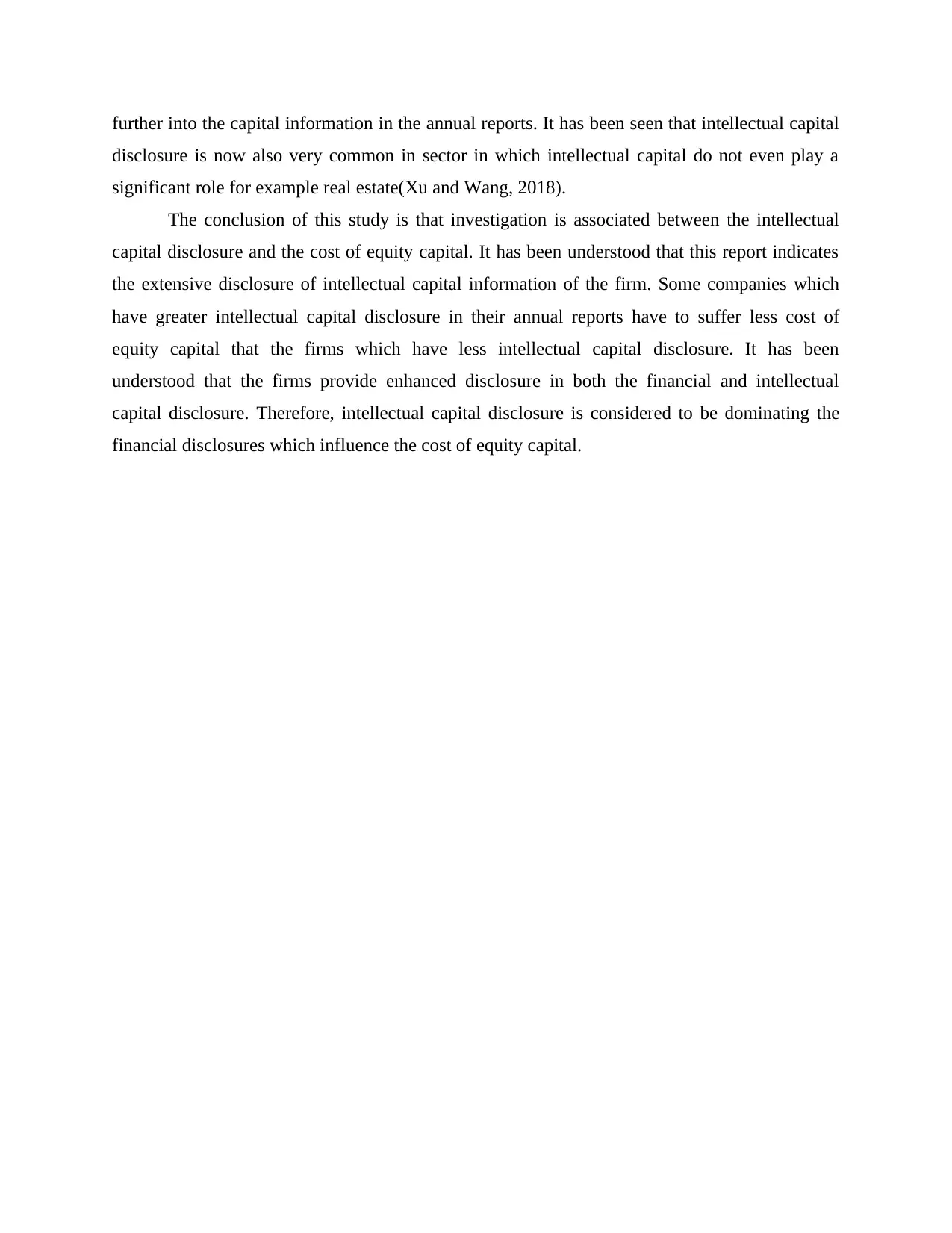
further into the capital information in the annual reports. It has been seen that intellectual capital
disclosure is now also very common in sector in which intellectual capital do not even play a
significant role for example real estate(Xu and Wang, 2018).
The conclusion of this study is that investigation is associated between the intellectual
capital disclosure and the cost of equity capital. It has been understood that this report indicates
the extensive disclosure of intellectual capital information of the firm. Some companies which
have greater intellectual capital disclosure in their annual reports have to suffer less cost of
equity capital that the firms which have less intellectual capital disclosure. It has been
understood that the firms provide enhanced disclosure in both the financial and intellectual
capital disclosure. Therefore, intellectual capital disclosure is considered to be dominating the
financial disclosures which influence the cost of equity capital.
disclosure is now also very common in sector in which intellectual capital do not even play a
significant role for example real estate(Xu and Wang, 2018).
The conclusion of this study is that investigation is associated between the intellectual
capital disclosure and the cost of equity capital. It has been understood that this report indicates
the extensive disclosure of intellectual capital information of the firm. Some companies which
have greater intellectual capital disclosure in their annual reports have to suffer less cost of
equity capital that the firms which have less intellectual capital disclosure. It has been
understood that the firms provide enhanced disclosure in both the financial and intellectual
capital disclosure. Therefore, intellectual capital disclosure is considered to be dominating the
financial disclosures which influence the cost of equity capital.
⊘ This is a preview!⊘
Do you want full access?
Subscribe today to unlock all pages.

Trusted by 1+ million students worldwide
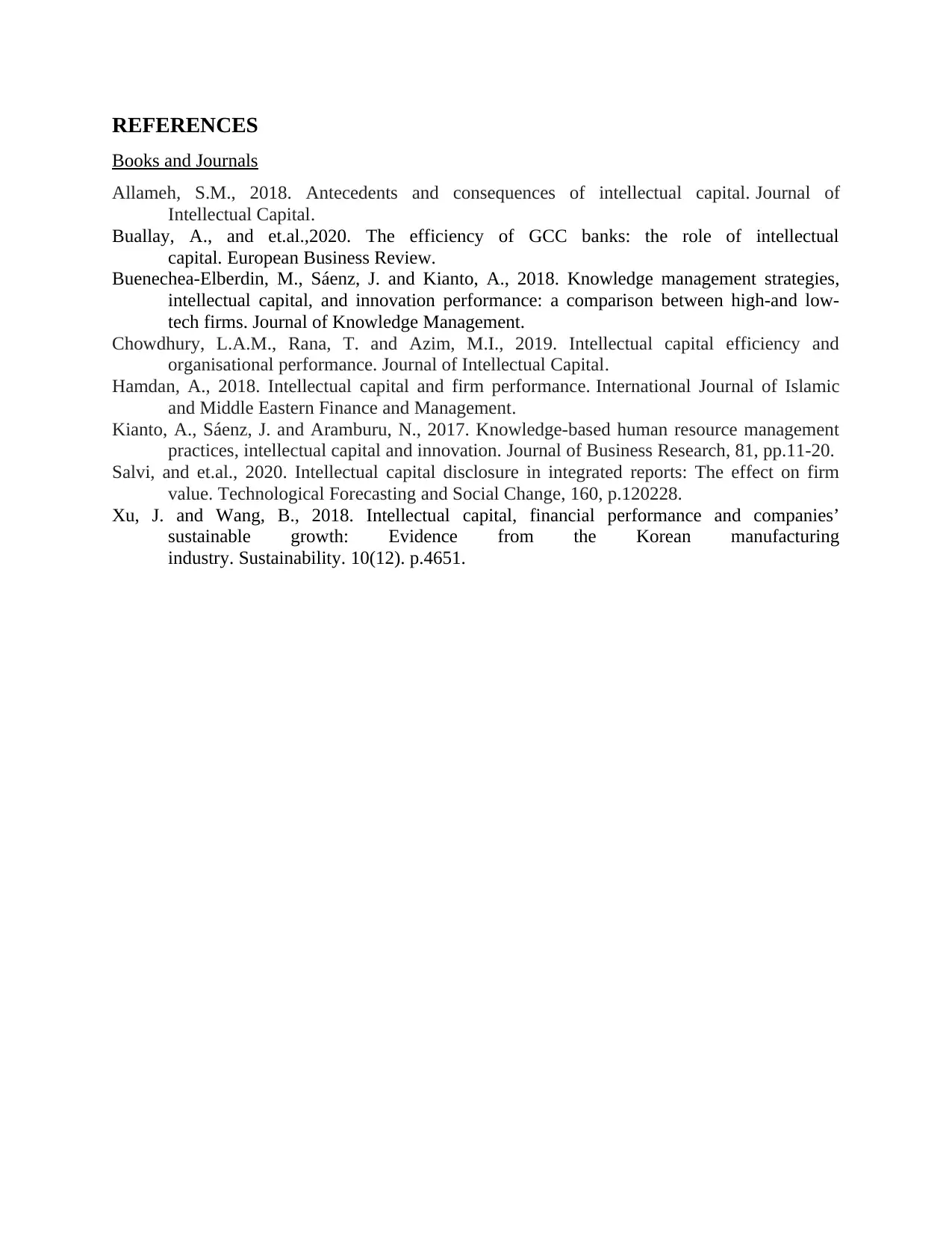
REFERENCES
Books and Journals
Allameh, S.M., 2018. Antecedents and consequences of intellectual capital. Journal of
Intellectual Capital.
Buallay, A., and et.al.,2020. The efficiency of GCC banks: the role of intellectual
capital. European Business Review.
Buenechea-Elberdin, M., Sáenz, J. and Kianto, A., 2018. Knowledge management strategies,
intellectual capital, and innovation performance: a comparison between high-and low-
tech firms. Journal of Knowledge Management.
Chowdhury, L.A.M., Rana, T. and Azim, M.I., 2019. Intellectual capital efficiency and
organisational performance. Journal of Intellectual Capital.
Hamdan, A., 2018. Intellectual capital and firm performance. International Journal of Islamic
and Middle Eastern Finance and Management.
Kianto, A., Sáenz, J. and Aramburu, N., 2017. Knowledge-based human resource management
practices, intellectual capital and innovation. Journal of Business Research, 81, pp.11-20.
Salvi, and et.al., 2020. Intellectual capital disclosure in integrated reports: The effect on firm
value. Technological Forecasting and Social Change, 160, p.120228.
Xu, J. and Wang, B., 2018. Intellectual capital, financial performance and companies’
sustainable growth: Evidence from the Korean manufacturing
industry. Sustainability. 10(12). p.4651.
Books and Journals
Allameh, S.M., 2018. Antecedents and consequences of intellectual capital. Journal of
Intellectual Capital.
Buallay, A., and et.al.,2020. The efficiency of GCC banks: the role of intellectual
capital. European Business Review.
Buenechea-Elberdin, M., Sáenz, J. and Kianto, A., 2018. Knowledge management strategies,
intellectual capital, and innovation performance: a comparison between high-and low-
tech firms. Journal of Knowledge Management.
Chowdhury, L.A.M., Rana, T. and Azim, M.I., 2019. Intellectual capital efficiency and
organisational performance. Journal of Intellectual Capital.
Hamdan, A., 2018. Intellectual capital and firm performance. International Journal of Islamic
and Middle Eastern Finance and Management.
Kianto, A., Sáenz, J. and Aramburu, N., 2017. Knowledge-based human resource management
practices, intellectual capital and innovation. Journal of Business Research, 81, pp.11-20.
Salvi, and et.al., 2020. Intellectual capital disclosure in integrated reports: The effect on firm
value. Technological Forecasting and Social Change, 160, p.120228.
Xu, J. and Wang, B., 2018. Intellectual capital, financial performance and companies’
sustainable growth: Evidence from the Korean manufacturing
industry. Sustainability. 10(12). p.4651.
1 out of 7
Related Documents
Your All-in-One AI-Powered Toolkit for Academic Success.
+13062052269
info@desklib.com
Available 24*7 on WhatsApp / Email
![[object Object]](/_next/static/media/star-bottom.7253800d.svg)
Unlock your academic potential
Copyright © 2020–2025 A2Z Services. All Rights Reserved. Developed and managed by ZUCOL.





